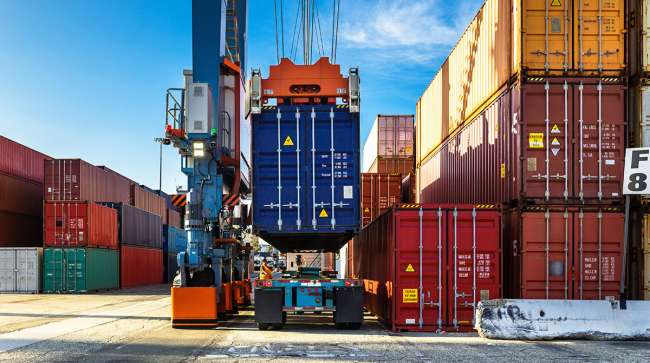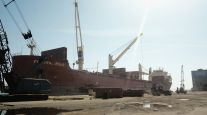Senior Reporter
West Coast Ports See Rebound in Container Volumes

[Stay on top of transportation news: Get TTNews in your inbox.]
Twin Southern California ports Long Beach and Los Angeles reported solid year-over-year increases in cargo container volume in October.
The Port of Long Beach notched a 14.7% year-over-year increase, moving 755,150 20-foot-equivalent containers compared with 658,428.
“Cargo is rebounding, and we are continuing to collaborate with our industry partners to recapture market share and invest in infrastructure that will position us for future growth,” Port of Long Beach CEO Mario Cordero said. “We are anticipating moderate growth through the rest of the year as retailers continue to stock shelves for the winter holidays.”
Year-to-date, Long Beach still is down 17.8% from the same period in 2022, which would return the port to pre-COVID 19 levels of cargo.
POLB's October cargo rose for a 2nd consecutive month amid preparations for the upcoming holiday shopping season and ongoing efforts to recapture market share. Dockworkers and terminal operators moved 755,150 TEUs last month, up 14.7% from October 2022. https://t.co/zwE6UpwwMc pic.twitter.com/U2LKcTOlQi — Port of Long Beach (@portoflongbeach) November 15, 2023
The adjacent Port of Los Angeles reported a 7% increase to 725,774 TEUs compared with 678,429 a year ago.
“Our terminal operators, labor and other stakeholders have worked hard to earn cargo market share back over the last three months,” Port of Los Angeles Executive Director Gene Seroka said. “Additionally, November is also shaping up to be a strong month as we see a final holiday push and warehouse replenishment.”
The Port of Los Angeles is down 16.6% compared to 2022 year-to-date.
Port officials also announced Zim Integrated Shipping Services is relaunching its 12½-day express service from south China direct to Los Angeles. The service was suspended in March because of slumping demand. The first ship is due to arrive at Los Angeles in early December.
For the third consecutive month, Port of Los Angeles cargo volume increased compared to the previous year. The Port processed 725,775 Twenty-Foot Equivalent Units (TEUs) in October, a 7% improvement compared to last year. https://t.co/uUmEavR5n2 pic.twitter.com/vA5ventUBI — Port of Los Angeles (@PortofLA) November 17, 2023
The Port of Oakland reported an 11.8% year-over-year decline in container volume, processing 178,627 containers in October compared with 202,487.

Brandes
While overall container numbers are down, Oakland officials pointed to an increase in exports, especially agriculture-related products, which saw a 4% year-over-year gain while imports sagged.
“Our port remains the preferred export gateway for fruits, nuts, meats and grains since we are the closest to agricultural areas in the central valley,” Port of Oakland Maritime Director Bryan Brandes said. “We also offer the fastest transit times to Asia since we are the last port of call in the U.S. before ships go back across the Pacific.”
With direct rail lines to the Midwest farm belt and central California’s rich agricultural basin, Oakland has increasingly focused on agriculture products.
The #PortofOakland October export container volume rose to the highest volume in any single month seen in 2023. Get the details here: https://t.co/Gu6YKcwRj2 #containervolume #exports #imports pic.twitter.com/zgoL02cMci — Port of Oakland (@PortofOakland) November 17, 2023
The dual ports of Seattle and Tacoma, Wash., operated by the Northwest Seaport Alliance, reported a 0.9% increase, processing 274,626 TEUs compared with 272,129 a year ago.
Port officials Nov. 17 also welcomed the arrival of two new super Post-Panamax cranes standing 316 feet tall with a 240-foot outreach boom that will be operating at Seattle’s Terminal 5. The cranes are capable of servicing the largest ships that operate on the Pacific Ocean.
Another week, another Terminal 5 construction update! Work continues on the south berth, as pile repairs are over three quarters complete, and falsework and concrete pours continue. pic.twitter.com/TlNI4TCt73 — The Northwest Seaport Alliance (@SeaportNW) November 10, 2022
Port Houston reported a 2% year-over-year decline in container volume, processing 366,208 TEUs, compared with 371,994.
Still, officials said loaded exports are up 10% year-to-date with resins and chemicals being the primary product moving through the port.
Port Houston is the top resins hub in the nation as well as home to North America’s largest petrochemical cluster.
On the East Coast, the Port of Savannah, Ga., complex processed 449,007 TEUs in October and, while that number is down 18.7% compared with 2022’s 552,806 containers year-over-year, this year’s figure is the strongest month to date in 2023. Port officials also noted that it was a 5% increase over the same month in 2019, the most recent year not affected by the pandemic.
The Port of Savannah also noted that with millions of dollars invested in infrastructure projects, all of the berths at Savannah’s Garden City Terminal are open for the first time in 2½ years.
Record cargo at Inland Port Greer.
South Carolina’s two rail-served inland ports provide quick access to inland markets, ensuring goods efficiently flow to and from the Port of Charleston. pic.twitter.com/OoYfl1ie5q — South Carolina Ports (@SCPorts) November 14, 2023
South Carolina’s Port of Charleston reported an 8.5% decline in container volume, processing 235,006 TEUs compared with 256,879 a year ago.
The port complex also is relying more on rail service with the new Navy Base Intermodal Facility under construction. Projected to open in 2025, Class I railroads CSX and Norfolk Southern will operate out of that rail yard.
The Port of Virginia reported a 3.7% year-over-year decline in container volume, processing 306,574 containers in October, compared with 318,452 in 2022.
On Nov. 15 officials announced a joint venture partnership with the Rockefeller Group and the Matan Cos. to develop a 500-acre, five-million-square-foot industrial and logistics center in Suffolk, Va., to be called the Port 460 Logistics Center. The facility is expected to house heavy industry, logistics, advanced manufacturing, life sciences and warehouse uses. The project will have direct access to the Port of Virginia, which is in the midst of a multibillion-dollar infrastructure update.
The Matan Companies and @RockGroup announced this week they are partnering in the development of the Port 460 Logistics Center, a 5M-sf, 500-acre industrial center in Suffolk. Given its strategic port-centric location, the project will attract new users of the port to our region. pic.twitter.com/gg1vVnJC3M — The Port of Virginia (@PortofVirginia) November 16, 2023
“As the Port of Virginia continues to add capacity and improve service and efficiency, developments like this are essential to meet the demands of the supply chain industry, and to keep our port a location of choice for end users,” Port of Virginia CEO Stephen Edwards said.
Of all the major ports, New York-New Jersey reported the biggest decline in cargo volume in September, falling 21.6% to 660,553 containers compared with 842,219 a year ago.
Want more news? Listen to today's daily briefing below or go here for more info:




